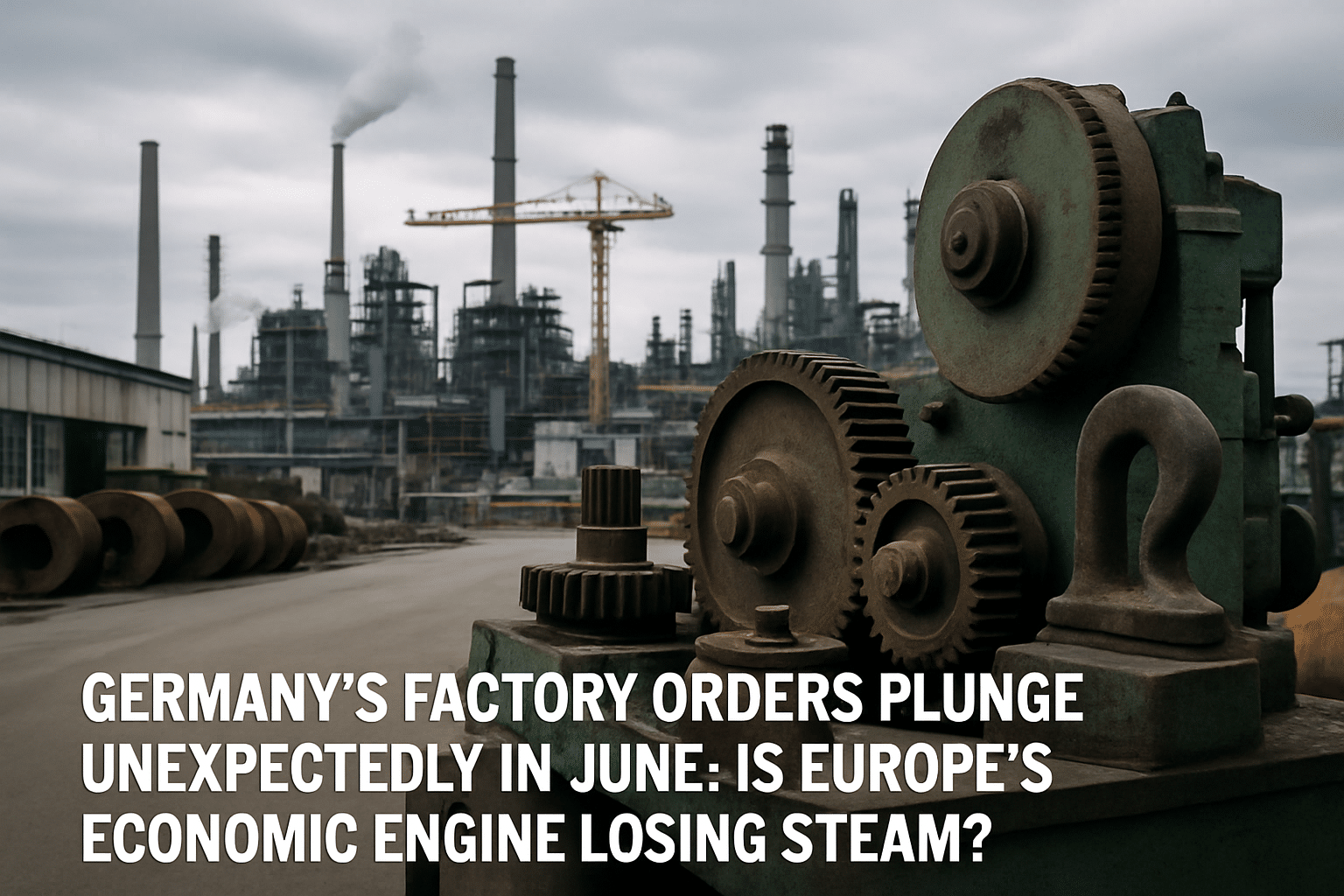A surprising 1.0% decline in Germany’s industrial orders during June has reignited concerns over the stability of the eurozone’s largest economy. The data, released by the Federal Statistical Office (Destatis), contradicted expectations of a 1.0% increase and signaled a second consecutive monthly contraction, highlighting persistent weakness in the German manufacturing sector amid rising global trade tensions and internal uncertainties.
A Shocking Miss: Forecasts Upended by Negative Momentum
Economists had projected a rebound in German factory orders for June, following a revised 0.8% drop in May. Instead, the sector extended its decline, confirming a trend that reflects both structural vulnerability and deteriorating demand conditions.
Despite a quarterly increase of 3.1% in orders between April and June, the month-to-month figures paint a far more volatile and concerning picture. The latest data suggest that industrial recovery in Germany is not only inconsistent, but increasingly dependent on external factors beyond domestic control.
Export Weakness Deepens: Global Demand Falters
The most dramatic shortfall came from outside the euro area. Orders from non-eurozone countries plummeted by 7.8% in June, compared to a 5.2% increase in orders from within the eurozone and a modest 2.2% rise in domestic demand. Overall, foreign orders declined by 3.0%, while domestic orders provided only a marginal buffer.
This imbalance underscores Germany’s longstanding reliance on international demand, especially from North America and Asia. The latest downturn reinforces the fragility of that model, particularly in an era defined by trade friction and geopolitical realignment.
Transport Equipment and Engineering Hit the Hardest
The steepest sectoral decline came from the transport equipment segment, which includes aircraft, trains, and military vehicles. Orders in this category dropped by 23.1%—a staggering monthly contraction that rippled across adjacent industries such as metals and automotive.
Germany’s powerful mechanical engineering sector also showed signs of strain. The VDMA, the German engineering association, reported a 5% year-on-year fall in orders for June, and a 2% decline in Q2 overall. The organization specifically cited uncertainty around U.S. tariffs and slowing global capital investment as key contributors to the downturn.
Tariffs and Uncertainty Cloud the Trade Outlook
A major drag on Germany’s export activity stems from renewed U.S. tariffs, introduced by the Trump administration in mid-2025. The 15% duty on industrial goods imported from the EU has created additional barriers for German manufacturers aiming to export to their second-largest trading partner.
At the same time, protracted negotiations over a new transatlantic trade agreement remain unresolved, further amplifying the regulatory uncertainty that discourages capital expenditure, disrupts production schedules, and delays hiring decisions across the German economy.
Broader Implications for the Eurozone and Global Investment
Weak factory data could compel the European Central Bank to reconsider its monetary tightening path. With inflation softening and industrial output weakening, the ECB may adopt a more cautious tone at upcoming policy meetings, potentially delaying further rate hikes.
From an investment perspective, Germany’s industrial malaise could deter foreign capital, especially in high-volatility sectors. International investors may redirect their focus toward U.S. equities or Asian markets, which currently offer more consistent growth narratives and regulatory clarity.
Outlook: Temporary Setback or Structural Decline?
The German economy finds itself at a critical juncture. Long viewed as the industrial backbone of Europe, it is now grappling with declining competitiveness, global protectionism, and a domestic investment gap.
While it’s too early to declare a prolonged downturn, the latest data raise fundamental questions about Germany’s ability to adapt its export-driven model to a world where supply chains are realigning, and economic alliances are shifting.
In this context, restoring business confidence, easing trade tensions, and accelerating domestic innovation will be key to reviving momentum. For now, however, the June factory orders serve as a stark reminder that Europe’s largest economy is far from immune to the headwinds shaping the global economic landscape.
Comparison, examination, and analysis between investment houses
Leave your details, and an expert from our team will get back to you as soon as possible
* This article, in whole or in part, does not contain any promise of investment returns, nor does it constitute professional advice to make investments in any particular field.
To read more about the full disclaimer, click here- orshu
- •
- 7 Min Read
- •
- ago 4 hours
 The Americas Markets Close Higher: Nasdaq Leads a Strong Day of Gains
The Americas Markets Close Higher: Nasdaq Leads a Strong Day of Gains
The trading day has concluded for the Americas, with major U.S. indices posting solid gains, driven by a positive market
- ago 4 hours
- •
- 7 Min Read
The trading day has concluded for the Americas, with major U.S. indices posting solid gains, driven by a positive market
- orshu
- •
- 8 Min Read
- •
- ago 9 hours
 European Markets Conclude Trading on a High Note: A Deeper Look at Today’s Performance
European Markets Conclude Trading on a High Note: A Deeper Look at Today’s Performance
European stock markets closed today with a largely positive performance, showcasing resilience and investor confidence despite a mixed bag of
- ago 9 hours
- •
- 8 Min Read
European stock markets closed today with a largely positive performance, showcasing resilience and investor confidence despite a mixed bag of
- orshu
- •
- 11 Min Read
- •
- ago 11 hours
 Why Does Every Minor Miss in Earnings Reports Trigger a Market Chain Reaction?
Why Does Every Minor Miss in Earnings Reports Trigger a Market Chain Reaction?
The second-quarter 2025 earnings season is proving to be one of the most paradoxical in recent years. On the surface,
- ago 11 hours
- •
- 11 Min Read
The second-quarter 2025 earnings season is proving to be one of the most paradoxical in recent years. On the surface,
- orshu
- •
- 6 Min Read
- •
- ago 11 hours
 Q2 Revenue Growth – Who’s Leading, Who’s Stable, and Who’s Falling Behind?
Q2 Revenue Growth – Who’s Leading, Who’s Stable, and Who’s Falling Behind?
The second quarter of 2025 marked a strong period for most major technology companies, highlighting a significant gap between the
- ago 11 hours
- •
- 6 Min Read
The second quarter of 2025 marked a strong period for most major technology companies, highlighting a significant gap between the












